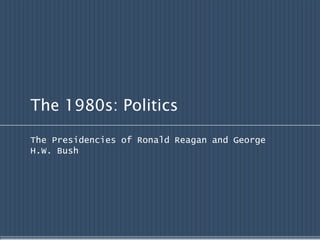
1980s Presidencies Reagan Bush Politics New Right Cold War
- 1. The 1980s: Politics The Presidencies of Ronald Reagan and George H.W. Bush
- 2. The Demographic of the 1980s Reagan ran for President in 1980 In 1980, the average American was older than in the 60s and more likely to live in the South and West By now, Americans were suspicious of federal power Many New Right activists (Part of a movement in response to countercultural protests of the 1960s. Most were evangelical Christians.) weren’t really worried about economic activities anymore. The group was worried about the culture of the nation. -Abortion, pornography, homosexuality, feminism and affirmative action were frowned upon. -New Right activists were also crusaders of prayer in schools and greater penalties for crimes.
- 3. Reagan’s Stance President Reagan naturally sided with the New Right on social issues He denounced the activist government and social engineering of the 60s Reagan championed the common man against big government
- 4. Reagan’s Stance Cont. Similar to the Brain Trust of FDR, Reagan drew on the ideas of “neoconservatives”. -This group, along with President Reagan, advocated free market capitalism and took anti-soviet positions in foreign policy -They also questioned welfare programs and policies that ensure equality * -Reagan and the neoconservatives also wanted traditional values of individualism and centrality of family re-established
- 5. The Second Term Reagan was very confident with his chances at winning a second term because the economy was doing well and the people loved him. He won the nomination in 1984 His opponent, Walter Mondale, made history by naming his VP Congresswoman Geraldine Ferraro, who was the first woman to appear on a major presidential ticket On election day, Ronald Reagan swept the nation winning everywhere but Minnesota and D.C.
- 6. Second Term Key Issues In President Reagan’s second term, the main topic was foreign policy. The Soviet Union had just elected a new leader, Mikhail Gorbachev, who proposed 2 policies: -“openness” which was aimed to allow “air” into the Soviet society by bringing about free speech and some political freedom -“restructuring” which was supposed to revive the bad economy by adopting free-market practices Both policies required the Soviets to greatly reduce military size and redirect attention to the economy
- 7. Second Term Key Issues Cont. The Cold War had to end and Gorbachev extended a hand to do so by announcing, in 1985, that the Soviets wouldn’t fire any immediate range nuclear forces (INF) toward Western Europe Reagan and Gorbachev met in four summit meetings to discuss this plan At the third meeting, the two agreed on policy and signed the INF treaty which didn’t allow any immediate-range nuclear missiles from Europe
- 8. George H.W. Bush In 1986, the Republicans lost the majority in the Senate, which was a hopeful sign to Democrats that the Reagan administration might finally be turning weaker For Presidency, the Democrats nominated Michael Dukakis who was a former Massachusetts governor -Front-runner on the Democratic ticket, Senator Gary Hart from Colorado, was forced to drop out of the race because of sexual misconduct charges The Republicans nominated George H.W. Bush who had been President Reagan’s vice president -George H.W. Bush ran on Reagan’s previous activities such as tax cuts, strong defense policies, toughness on crime, anti- abortion views, etc.
- 9. George H.W. Bush and the First Months Bush won the race with about 6 million more votes than his competitor At the beginning of his presidency it seemed that the whole world was out to achieve democracy for their governments, especially China (although China’s government suppressed the prodemocracy movement with vicious tactics) -Communist governments everywhere collapsed, which meant an end to the Cold War after 45 years
- 10. The First Months Cont. The collapse of the USSR was an astonishing event in the short months after Bush’s election -When the USSR broke up, the 40 plus years of tension between the nuclear powers of the United States and the USSR went away
- 11. Bush and the Persian Gulf In 1990, Saddam Hussein invaded the tiny country of Kuwait because Iraq needed money to pay for the war it had just ended with Iran The U.N. security council demanded that Saddam leave Kuwait by January 15, 1991 or force would be used to expel him from the nation The U.S. and 28 other countries sent about 800 thousand troops to the Persian Gulf -Efforts to resolve the issue failed, and Congress voted to use force to remove Hussein
- 12. Bush and the Persian Gulf Cont. Operation Desert Storm commenced in late February -U.N. forces rapidly headed deep into Iraq, which cut of the enemy’s capability of retreating or getting reinforcements -The Allies had few casualties, however Iraq struggled with the loss of most of its troops -On February 27, just four days after Desert Storm began, Saddam Hussein waved the white flag and Kuwait was set free
- 13. President Bush and the Home Front He signed the Americans with Disabilities Act in 1990, which was a law prohibiting discrimination against disabled Americans Bush also brought into law a water projects bill that put environmental issues in front of agricultural ones He angered Americans with his actions in education (challenged legality of college scholarships that were given to minorities) and civil rights (warned that he would veto bills making it easier for people to see if they were being discriminated against in the workplace)
- 14. President Bush and the Home Front Cont. President Bush ended his term with a poor economy (even though it had struggled since day 1 of his administration), over 7% unemployment and a huge federal budget deficit that was $250 billion bigger every year he was president Bush did not get re-elected, and William Clinton was put into office next
